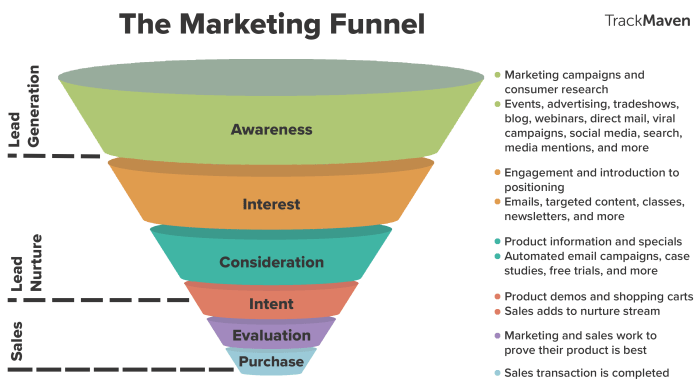Building a Marketing Funnel sets the stage for a deep dive into the world of strategic customer engagement, where businesses create dynamic pathways to drive conversions and loyalty, all while staying ahead of the curve in a fast-paced digital landscape.
Let’s explore the key components that make up a successful marketing funnel and how businesses can leverage them to maximize their marketing efforts.
What is a Marketing Funnel?
A marketing funnel is a framework used by businesses to visualize the customer journey from awareness to conversion. It represents the stages a potential customer goes through before making a purchase, helping companies understand and optimize their marketing strategies.
Stages of a Typical Marketing Funnel
The typical marketing funnel consists of the following stages:
- Awareness: This is the stage where potential customers become aware of a business or product through marketing efforts such as advertising, content marketing, or social media.
- Interest: Once aware, customers show interest in the product or service, engaging further with the brand through actions like signing up for newsletters or following social media accounts.
- Consideration: In this stage, customers evaluate the product or service, comparing it with competitors and considering its benefits and features.
- Intent: At this stage, customers demonstrate the intention to purchase, showing strong interest and actively seeking more information.
- Decision: The final stage where customers make the decision to buy, completing the purchase and becoming a customer.
Examples of How Businesses Use Marketing Funnels
Businesses use marketing funnels in various ways to attract, engage, and convert customers:
- Lead Generation: By creating awareness and interest, businesses generate leads that can be nurtured through the funnel towards conversion.
- Email Marketing: Businesses use email marketing to move potential customers through the funnel by providing valuable content and offers based on their stage in the journey.
- Remarketing: Targeting customers who have shown interest but not converted, businesses use remarketing ads to bring them back into the funnel and encourage conversion.
- Analytics: By analyzing data at each stage of the funnel, businesses can identify bottlenecks, optimize strategies, and improve overall conversion rates.
Building Awareness
Building awareness is a crucial step in the marketing funnel as it helps to introduce your brand to potential customers and make them familiar with what you offer. This stage aims to grab the attention of your target audience and create an initial interest in your products or services.
Social Media Marketing for Awareness
Social media platforms play a vital role in building brand awareness due to their extensive reach and ability to engage with a large audience. By utilizing social media marketing strategies such as creating engaging content, running targeted ads, and collaborating with influencers, businesses can effectively increase their brand visibility and reach a wider audience.
- Create compelling content that resonates with your target audience and encourages sharing to expand your reach.
- Utilize social media ads to target specific demographics and increase brand visibility among potential customers.
- Partner with influencers or brand ambassadors to leverage their large following and credibility to promote your brand to a broader audience.
Successful Awareness Campaigns
One example of a successful awareness campaign is the “Share a Coke” campaign by Coca-Cola. This campaign featured personalized Coke bottles with individual names, encouraging customers to find and share bottles with their names on social media. The campaign went viral, generating a buzz around the brand and increasing consumer engagement.
Another example is the “Dove Real Beauty” campaign, which focused on promoting body positivity and self-acceptance. Through powerful ad campaigns and social media content, Dove successfully raised awareness about their brand values and mission, resonating with their target audience and creating a strong emotional connection with consumers.
Generating Leads
Generating leads is a crucial part of the marketing funnel as it involves capturing potential customers and guiding them towards making a purchase. There are various techniques and methods that can be used to effectively generate leads and convert them into paying customers.
Content Marketing
Content marketing is a powerful lead generation method that involves creating and sharing valuable content to attract and engage a target audience. By providing relevant and informative content, businesses can establish themselves as industry experts and build trust with potential customers. This can be done through blog posts, articles, videos, infographics, and more.
Email Campaigns
Email campaigns are another effective way to generate leads by reaching out to potential customers directly. By creating personalized and targeted email campaigns, businesses can nurture leads, provide valuable information, and promote products or services. It is important to segment the email list, create compelling subject lines, and include clear calls to action to encourage recipients to take the desired action.
(Search Engine Optimization)
plays a crucial role in lead generation by improving a website’s visibility and ranking on search engine results pages. By optimizing website content, meta tags, and s, businesses can attract organic traffic and generate leads from users actively searching for relevant products or services. It is important to regularly update and optimize the website to maintain a strong online presence and attract quality leads.
Optimizing Lead Generation Strategies
– Utilize lead magnets such as ebooks, webinars, or free trials to capture leads’ contact information.
– Implement A/B testing to optimize landing pages, forms, and email campaigns for maximum conversion rates.
– Use social media platforms to promote content and engage with potential customers.
– Collaborate with influencers or industry partners to reach a wider audience and generate leads.
– Analyze data and metrics to track lead generation efforts and make data-driven decisions to improve strategies.
Nurturing Leads
Lead nurturing is a crucial aspect of the marketing funnel as it involves building relationships with potential customers at every stage of their journey. By providing valuable information, personalized content, and continuous engagement, businesses can guide leads through the funnel, increasing the likelihood of conversion.
Personalized content plays a significant role in enhancing lead nurturing efforts by tailoring messages to the specific needs and interests of individual leads. This approach helps create a more personalized experience, making leads feel valued and understood, ultimately increasing the chances of conversion.
Importance of Personalized Content in Lead Nurturing
- Personalized emails with relevant content based on lead behavior and preferences
- Dynamic website content that adapts to lead interactions and interests
- Customized landing pages with targeted messaging to address specific pain points
Examples of Effective Lead Nurturing Workflows
- Automated email sequences that deliver relevant content at each stage of the buyer’s journey
- Retargeting ads that remind leads of products they have shown interest in
- Personalized follow-up calls or messages based on previous interactions
Converting Leads into Customers

To convert leads into customers, it is essential to have a well-defined strategy in place. This involves nurturing the leads through targeted communication, understanding their needs, and providing them with the right incentives to make a purchase.
Different Conversion Techniques
- Discounts: Offering discounts on products or services can be a powerful incentive for leads to make a purchase. This can be in the form of a percentage off, a dollar amount off, or buy-one-get-one deals.
- Free Trials: Providing leads with a free trial of your product or service allows them to experience its benefits firsthand. This can help build trust and confidence, making them more likely to convert into paying customers.
- Limited-Time Offers: Creating a sense of urgency through limited-time offers can push leads to make a decision quickly. This can include flash sales, exclusive discounts for a short period, or limited stock availability.
Case Studies of Successful Lead Conversion Campaigns, Building a Marketing Funnel
One successful lead conversion campaign was run by Company X, which offered a 20% discount to leads who signed up for their email list. This resulted in a 15% increase in conversions within the first month.
Another case study involves Company Y, which provided a free trial of their software for 7 days. This led to a 25% increase in customer acquisition and a 30% increase in customer retention.
Retaining Customers
Customer retention is a crucial aspect of the marketing funnel as it focuses on keeping existing customers engaged and satisfied, ultimately leading to repeat purchases, brand loyalty, and positive word-of-mouth referrals.
Customer Loyalty Programs
Customer loyalty programs are designed to incentivize customers to continue doing business with a company by offering rewards, discounts, or exclusive benefits. These programs help in retaining customers by fostering a sense of appreciation and value, encouraging repeat purchases, and creating a strong emotional connection between the customer and the brand.
- Lululemon: The athletic apparel retailer Lululemon has a successful customer retention strategy through its loyalty program called “Sweat Collective.” Members receive various benefits such as exclusive access to new products, free shipping, and invitations to special events, creating a community of loyal customers.
- Starbucks: Starbucks’ Rewards program allows customers to earn points for every purchase, which can be redeemed for free drinks or food items. The program also offers personalized promotions and rewards based on individual preferences, enhancing the overall customer experience and encouraging repeat visits.
Measuring Success: Building A Marketing Funnel

In order to determine the effectiveness of a marketing funnel, it is essential to track key metrics that provide insight into how well the funnel is performing. By analyzing these metrics, marketers can make informed decisions to optimize their strategies and improve overall results.
Key Metrics to Track
- Conversion Rate: Measure the percentage of leads that end up making a purchase. This indicates how well your funnel is at converting leads into customers.
- Cost per Acquisition (CPA): Calculate how much it costs to acquire a new customer. This helps in evaluating the efficiency of your marketing efforts.
- Customer Lifetime Value (CLV): Determine the total revenue a customer is expected to generate throughout their relationship with your business. This metric helps in assessing the long-term impact of your funnel.
- Churn Rate: Monitor the rate at which customers stop engaging with your business. A high churn rate could indicate issues with customer retention strategies.
Tools and Software for Monitoring
There are various tools and software available to help marketers monitor and analyze the performance of their marketing funnels. Some popular options include:
- Google Analytics: Provides detailed insights into website traffic, conversions, and user behavior.
- HubSpot: Offers a comprehensive platform for inbound marketing, including tools for lead generation and customer relationship management.
- Crazy Egg: Enables heat mapping and user behavior analysis to optimize website design and conversion rates.
Best Practices for Interpretation
- Regularly review and analyze data to identify trends and patterns that can guide decision-making.
- Set specific goals and benchmarks to measure the success of your marketing funnel and track progress over time.
- A/B testing: Experiment with different strategies to see which ones yield the best results and make data-driven adjustments accordingly.
- Collaborate with other team members to gain diverse perspectives on interpreting data and brainstorming improvement ideas.





